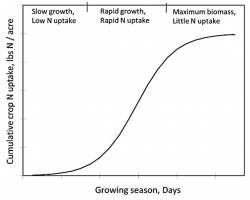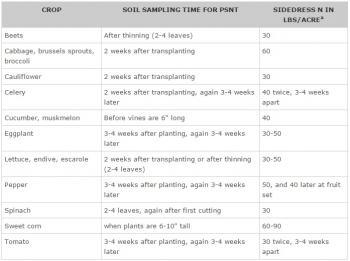Pre-Sidedress Nitrate Test
Topdressing is defined as a fertilizer application to a crop any time after planting. In popular usage, topdressing sometimes refers to a broadcast application of fertilizer made after planting. However, fertilizer can also be sidedressed as a band along the side of the row of a growing crop. Sidedressing is commonly done immediately before or during cultivation. When urea containing fertilizers are used, cultivation helps reduce volatilization losses.
Sidedressing of relatively soluble N fertilizer is an important component of efficient nitrogen management. The N accumulation pattern for annual crops is very similar to biomass accumulation (Figure 1). Early in the season, when crop growth is slow, crop N needs are very small. A starter fertilizer is generally sufficient to satisfy those needs. Any soil nitrate in excess of crop N needs during this period is prone to leaching and/or denitrification losses. The next phase of crop development is characterized by rapid vegetative growth. The N demand during this phase is the highest of the growing season. As much as 85% of the total N uptake occurs during this period. Efficient recovery of fertilizer N can be achieved by sidedressing fertilizer N immediately before this phase. Delaying application of a large portion N fertilizer until sidedress also allows growers to use the Pre-sidedress Soil Nitrate Test (PSNT) to help determine N needs.

Figure 1. Generalized nitrogen accumulation curve for annual crops
Pre-sidedress Soil Nitrate Test (PSNT)
The dynamic nature of the N cycle, its sensitivity to weather, and variation in N availability between fields limits the value of routine, pre-season soil testing for predicting N availability during the season in our humid environment. Sandy soils low in organic matter also leach nitrogen quickly in spring rains, whereas soils high in organic matter tie up nitrogen to aid in the decomposition of newly incorporated organic material.
However, under certain circumstances, in-season soil testing has proven useful. The PSNT, developed by Dr. Fred Magdoff at the University of Vermont in the early 1980’s, was originally intended to help estimate the amount of available N for field corn in fields where manure had been applied and/or forage legumes were grown in rotation. Over the last thirty years, research conducted in the Northeast has shown the PSNT useful for improving N management of several vegetable crops including sweet corn, peppers, pumpkin, winter squash, and cabbage. The PSNT is most suitable for use with annual crops, which accumulate N rapidly within a single growing season. The PSNT measures the current level of nitrate in the soil to predict the amount of N available for the remaining period of crop growth. This information can help growers avoid use of excess fertilizers, reduce runoff, and get higher returns to labor and fertilizer investments.
The PSNT is especially useful in soils high in organic matter or soils that have had organic matter tilled in before planting, where large amounts of N from mineralization are expected. The test works best when pre-plant and starter fertilizer N rates are less than about 50 lbs N per acre. PSNT samples are collected about a week before the rapid growth phase (see Figure 3), to provide an indication of how much N has been made available from mineralization. During wet springs with heavy leaching rains, or in sandy soils with rapid losses, the PSNT will also provide some indication of how much N remains in the root zone.
Interpreting PSNT results
As with all soil testing, information from a PSNT should be used along with the grower’s experience and knowledge of the field and with environmental conditions taken into account. Interpretation of the PSNT is also crop specific. Research in the Northeast has determined soil nitrate N thresholds, above which additional fertilizer N applications will not increase yields. For most vegetable crops except for sweet corn, if soil nitrate is above 30 ppm, additional N will not increase yields and may in fact result in reduced yields. For sweet corn, the threshold is 25 ppm soil nitrate.
Determining sidedressing rates based on PSNT results
When PSNT values are below threshold levels, the appropriate rate of sidedress N should be determined based on the level of nitrate N reported, previous N application, realistic yield expectation, the field’s management history, and growing season conditions. For example, soils high in organic matter will continue to release N throughout the season. Research indicates that for each 1% organic matter, we can expect 20 to 40 lb of N per acre per year to be mineralized when conditions are favorable. Reduce sidedressing amounts to reflect the nitrogen credit coming from organic matter.
In general, for vegetable crops except for sweet corn, if soil nitrate is 0-25 ppm, apply the full sidedress amount recommended in Table 1. If soil nitrate levels are 25-30 ppm, cut the sidedress rate in half. Above 30 ppm, no additional N application is necessary, and may reduce yield. See Table 1 for recommendations on timing of sampling and making sidedressing applications of N based on PSNT for many vegetable crops.
Table 1. Timing of PSNT and sidedress nitrogen needs of crops
Adapted from: Rutgers Cooperative Extension Bulletin by J. Heckman, “Soil Nitrate Testing as a Guide to Nitrogen Management for Vegetable Crops”
Forms of nitrogen fertilizer
Nitrogen is available in a number of forms; consult pages 37-38 of the Nutrient Management Guide for New England Vegetable Production for nitrogen options for organic and non-organic growers. Common sources of fertilizer N include urea, ammonium nitrate, monoammonium phosphate, diammonium phosphate, calcium nitrate and potassium nitrate. Sulphur-coated urea is a material which releases N more slowly over a period of several weeks. In the soil, urea is converted by hydrolysis to ammonium, which in turn is converted through nitrification to nitrate. This process slightly acidifies soil as hydrogen is released from ammonium (NH4) as it converts to Nitrate (NO3). In warm soils these reactions usually happen fairly quickly if soil pH is over 6.0 and soil moisture and aeration are adequate.
For organic growers options include: manure, meals and emulsions, or animal byproducts such as dried blood and feather meal. Not all of these forms are readily available to the crop, and selecting rapidly available forms of nitrogen may be preferable for sidedressing. Nitrate is the predominant form of N taken up by most plants, but any of these fertilizers can be used because they will be converted to nitrate eventually.
Many growers use calcium nitrate and sometimes potassium nitrate for topdressing or sidedressing N on crops subject to calcium related disorders. When a slow release form of urea is used, only a small amount of ammonium is present at a given time and is unlikely to cause a problem with calcium nutrition, but N may not be available quickly enough to meet the demands of a rapidly growing crop.
Sampling for PSNT
Samples for the PSNT should consist of a well-mixed composite of 10 to 20 cores or slices of soil to a depth of 12". This is a deeper sample than what it is recommended for routine soil sampling. A deeper sample is required for nitrate testing to accurately reflect the concentration in the effective root zone due to its mobility in soil. Avoid sampling fertilizer bands or areas that may have received extra N. About one cup of the composite should be dried to stabilize the nitrate. A good method is to spread a thin layer of the soil on a cookie sheet or aluminum foil to air dry. Use a fan to reduce drying time. Do not place damp samples on absorbent material because it can absorb some of the nitrate. You can skip the drying step if you can deliver the samples to the soil testing lab in less than 24 hours; however, samples should be kept cool. Fields should be sampled for the PSNT about a week before the time when sidedressing is normally done. This should allow adequate time for drying, shipping, and testing (turnaround time in the lab is about 24 hours) and for you to plan your fertilizer program.
PSNTs are available through the UMass Soil & Plant Nutrient Testing Lab.
Order form, with more detailed sampling information.
Samples should be delivered to:
Cornell Nitrogen Assessment Program, Adapt-N
Cornell University has developed an experimental N assessment program that can help growers decide if and how much sidedress N is needed for field corn and sweet corn. One unique aspect of the Adapt-N program is the incorporation of up-to-date rainfall amounts in the program obtained for land areas 3 miles by 3 miles square, which allows a custom estimation of the nitrate status of individual fields. If a grower wants to use this new experimental program, visit the Adapt-N website. The program is relatively easy to use and can provide information to optimize yield and nitrogen applications.
--adapted from “Topdressing and Sidedressing Nitrogen”, 2016 New England Vegetable Management Guide, and “Nitrogen Management with a Pre-Sidedress Soil Nitrogen Test”, K. Campbell-Nelson, UMass Vegetable Extension with thanks to J. Howell, UMass Extension and Joseph R. Heckman, Ph.D., Extension Specialist in Soil Fertility, Rutgers
The Center for Agriculture, Food and the Environment and UMass Extension are equal opportunity providers and employers, United States Department of Agriculture cooperating. Contact your local Extension office for information on disability accommodations. Contact the State Center Director’s Office if you have concerns related to discrimination, 413-545-4800 or see ag.umass.edu/civil-rights-information.
